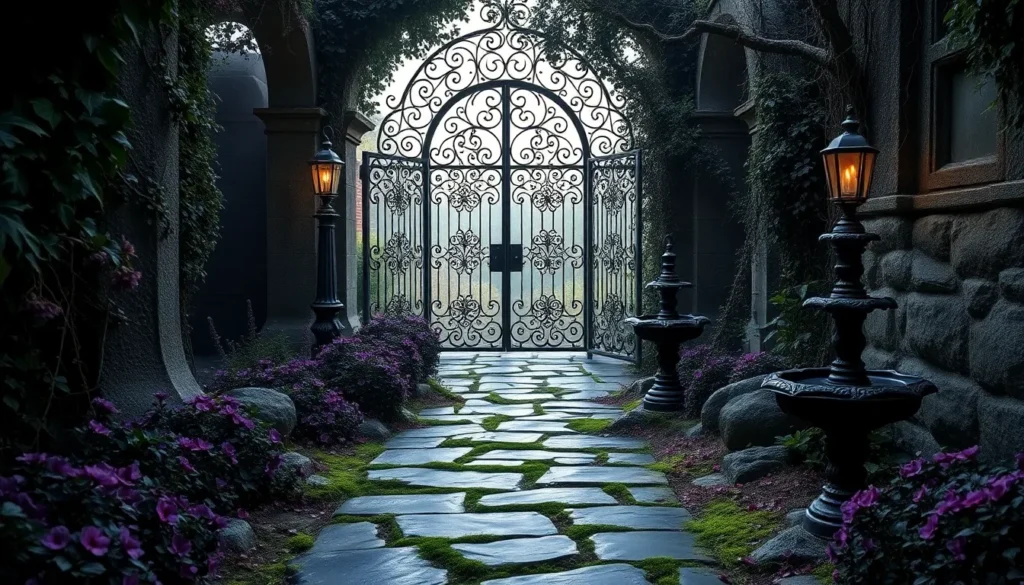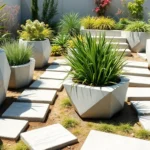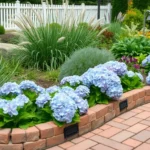Dark romance meets botanical beauty when we embrace the mysterious allure of gothic garden design. We’re transforming ordinary outdoor spaces into hauntingly elegant sanctuaries that celebrate the dramatic side of nature. These aren’t your grandmother’s flower beds – we’re talking about gardens that whisper stories of midnight blooms and shadowy pathways.
Gothic gardens blend Victorian elegance with supernatural charm creating spaces that feel both enchanting and slightly rebellious. We’re using deep purples black flowers wrought iron accents and weathered stone to create landscapes that look like they’ve stepped out of a Gothic novel. The result? Gardens that captivate visitors and create unforgettable atmospheric experiences.
Whether you’re drawn to the romance of moonlit courtyards or the drama of towering dark foliage we’ll show you how to create a gothic garden that’s both sophisticated and spellbinding. Your outdoor space is about to become the most intriguing feature of your property.
Create a Mysterious Entrance With Gothic Garden Gates
Gothic garden gates serve as the theatrical threshold between the ordinary industry and your darkly romantic sanctuary. We’ll explore three captivating gate styles that immediately establish your garden’s mysterious character.
Wrought Iron Designs With Intricate Patterns
Wrought iron gates featuring elaborate scrollwork and ornate metalwork create the perfect gothic entrance statement. Blackened iron formations with twisted vines, thorny roses, and Celtic knots transform simple entryways into dramatic focal points. We recommend incorporating pointed arch tops and decorative spear finials to enhance the medieval aesthetic.
Professional artisans often include bat motifs, gargoyle faces, or religious symbols within the ironwork patterns. Weathered finishes and rust patina effects add authentic aged character that complements surrounding stone elements. Install gas lanterns or flickering LED candles on either side to cast dancing shadows through the intricate metalwork after sunset.
Stone Archways Covered in Dark Ivy
Stone archways draped in climbing ivy create natural gothic portals that feel centuries old. We suggest using limestone, granite, or weathered brick to construct substantial arches that frame your garden entrance magnificently. Dark English ivy, Boston ivy, or Virginia creeper provide the perfect cascading foliage to soften harsh stone edges.
Allow ivy tendrils to grow wild and untamed for maximum mysterious appeal. Incorporate carved stone details like grotesque faces, heraldic shields, or religious motifs into the archway structure. Moss and lichen growth on stone surfaces enhances the ancient, forgotten atmosphere that defines gothic garden aesthetics.
Medieval Inspired Wooden Doors
Massive wooden doors with heavy iron hardware transport visitors straight into medieval fairy tales. We recommend using reclaimed oak, cedar, or chestnut timber with deep staining to achieve that centuries old appearance. Decorative iron hinges, oversized ring handles, and studded metal accents complete the authentic medieval look.
Hand carved details such as Gothic arches, trefoil patterns, or coat of arms add personalized character to each door panel. Distressed finishes with strategic wear marks create believable aging effects. Install wrought iron speakeasy windows or decorative grilles to maintain security while preserving the mysterious gothic atmosphere throughout your garden entrance.
Design Dramatic Pathways Using Dark Materials
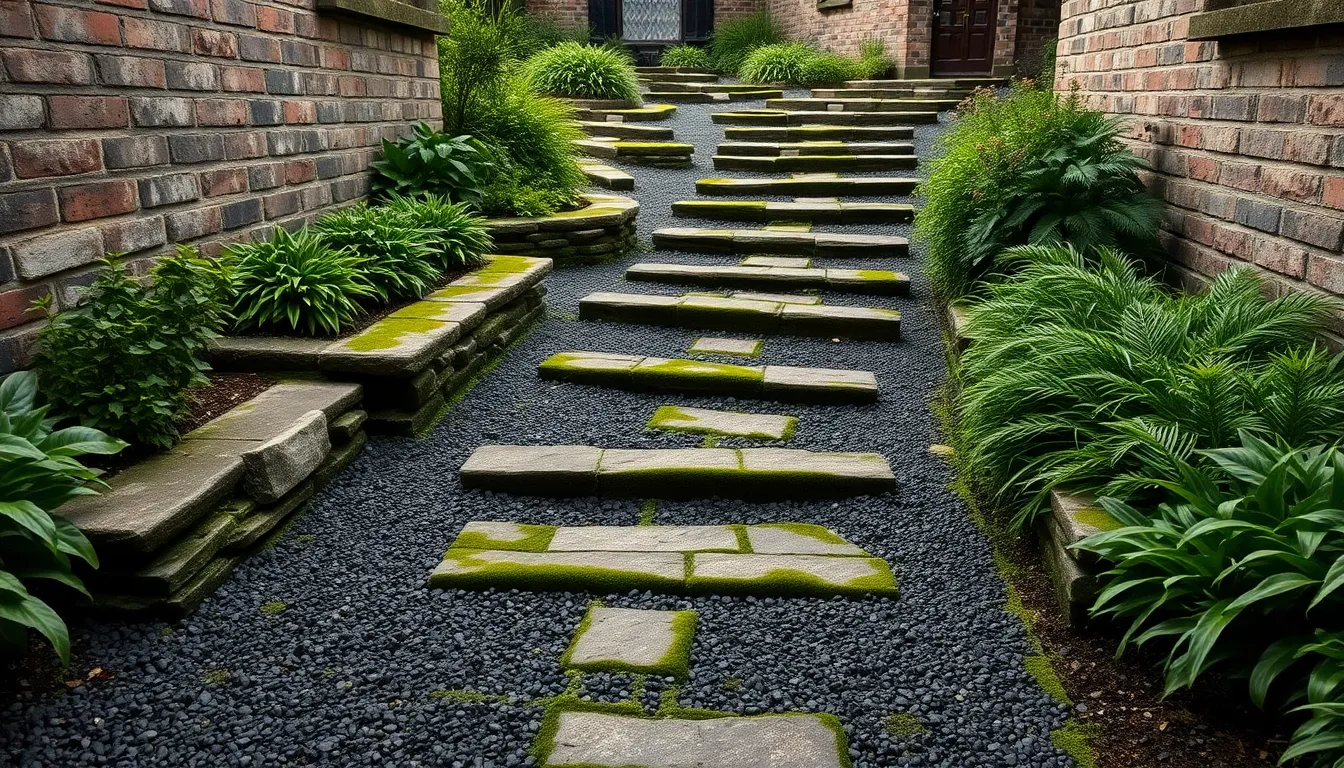
Once you’ve established your gothic garden entrance, the pathways become the arteries that guide visitors deeper into your mysterious industry. Dark materials create visual impact while maintaining the somber atmosphere essential to gothic garden design.
Black Gravel and Crushed Stone Walkways
Black gravel transforms ordinary pathways into dramatic corridors that enhance your gothic garden’s mysterious ambiance. We recommend using angular crushed stone rather than smooth pebbles to create texture that catches shadows throughout the day. The contrast between dark pathways and lighter plantings creates visual depth that draws the eye forward through your garden spaces.
Installation becomes straightforward when you prepare a solid base with industry fabric to prevent weeds from disrupting your dark aesthetic. Charcoal colored granite chips offer durability while maintaining the deep tones essential for gothic atmosphere. Regular maintenance involves raking to maintain crisp edges and adding fresh material annually to preserve the rich, dark appearance that defines your gothic walkways.
Weathered Brick Patterns in Herringbone Style
Weathered brick in herringbone patterns adds historical authenticity that perfectly complements gothic garden themes. We suggest sourcing reclaimed bricks with natural aging rather than artificially distressed materials to achieve genuine character. The zigzag pattern creates visual interest while directing foot traffic through your garden’s mysterious passages.
Antique red bricks develop beautiful patina over time, especially when combined with dark mortar that emphasizes the gothic aesthetic. Installation requires careful attention to spacing and alignment to achieve the classic herringbone look that evokes medieval courtyards. Moss naturally settles between bricks over time, adding to the aged appearance that makes gothic gardens feel authentically historical.
Natural Stone Steps With Moss Accents
Natural stone steps create elevation changes that add drama to your gothic garden while moss accents provide the weathered appearance essential to the style. We recommend using limestone or sandstone blocks that naturally develop moss coverage in shaded, moist conditions. These materials age gracefully and support the organic growth that softens harsh edges.
Creating moss friendly conditions involves maintaining consistent moisture and providing partial shade where steps meet soil areas. You can accelerate moss development by applying a mixture of yogurt and existing moss to new stonework, promoting natural coverage that enhances the ancient feel. Irregular stone placement creates an organic appearance that contrasts beautifully with formal garden elements while maintaining safe passage through your gothic industry.
Plant Dark Foliage for a Moody Atmosphere
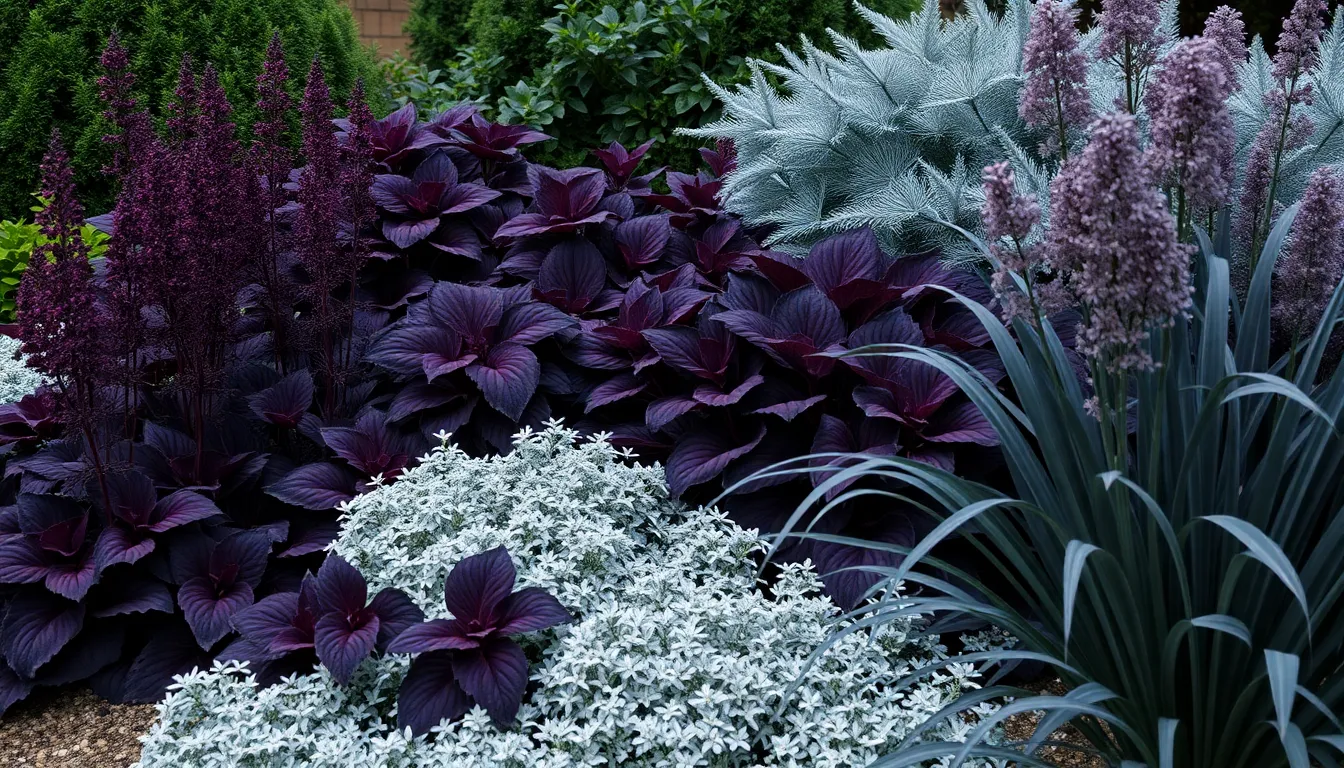
Dark foliage forms the backbone of our gothic garden design, creating the mysterious foundation that sets the entire mood. We’ll explore how strategic plant selection transforms ordinary spaces into captivating sanctuaries.
Deep Purple and Black Flower Varieties
Astilbe ‘Dark Side of the Moon’ delivers exceptional drama with its deep chocolate brown leaves and striking rosy-purple flowers. This perennial thrives in partial shade and creates stunning contrast against lighter elements in our gothic garden design.
Coleus ‘Black Prince’ offers nearly solid maroon-black foliage that maintains its intensity throughout the growing season. We recommend planting this annual in clusters to maximize its visual impact and create bold focal points.
Heuchera ‘Black Pearl’ features jet-black leaves with captivating rosy-purple undersides that catch light beautifully. The delicate white flowers provide subtle contrast while maintaining the plant’s dark aesthetic appeal.
Canna Tropicanna® Black combines deep bronze foliage with bold red flowers for maximum gothic drama. This tender herbaceous perennial creates vertical interest and serves as an excellent centerpiece in our dark garden compositions.
Black Mondo Grass provides dense purple-black grass-like foliage that works perfectly as groundcover or border edging. We use this perennial to create flowing transitions between larger gothic garden elements.
Silver and Gray Leafed Plants
Dusty Miller introduces silvery-gray foliage that creates striking contrast against our darker plant selections. These annuals reflect moonlight beautifully and add ethereal qualities to evening garden experiences.
Artemisia varieties offer feathery silver-gray leaves that provide textural diversity while maintaining our gothic color palette. We position these perennials strategically to break up dense dark areas and create visual breathing room.
Silver-leafed plants serve as natural highlighters in our gothic compositions, drawing the eye through carefully planned sight lines. Their pale coloration mimics weathered stone and adds aged authenticity to our mysterious garden atmosphere.
Evergreen Shrubs for Year-Round Drama
Ninebark Diabolo® maintains deep purple foliage throughout the seasons while producing creamy white flower clusters in spring. This shrub provides structural backbone and ensures our gothic garden retains its character year-round.
Elderberry Black Lace® features intricate lacy black foliage complemented by delicate pink flowers in summer. We use this shrub to create natural screens and add architectural interest to our gothic garden borders.
Weigela Dark Horse offers dark bronze foliage with purplish-pink flowers that bloom in late spring. This compact shrub works excellently in mixed plantings and maintains consistent color through multiple seasons.
Traditional evergreens like boxwood and holly provide the structural foundation our gothic gardens need during winter months. These reliable performers ensure our mysterious atmosphere persists even when deciduous plants enter dormancy.
Install Gothic Architecture Elements
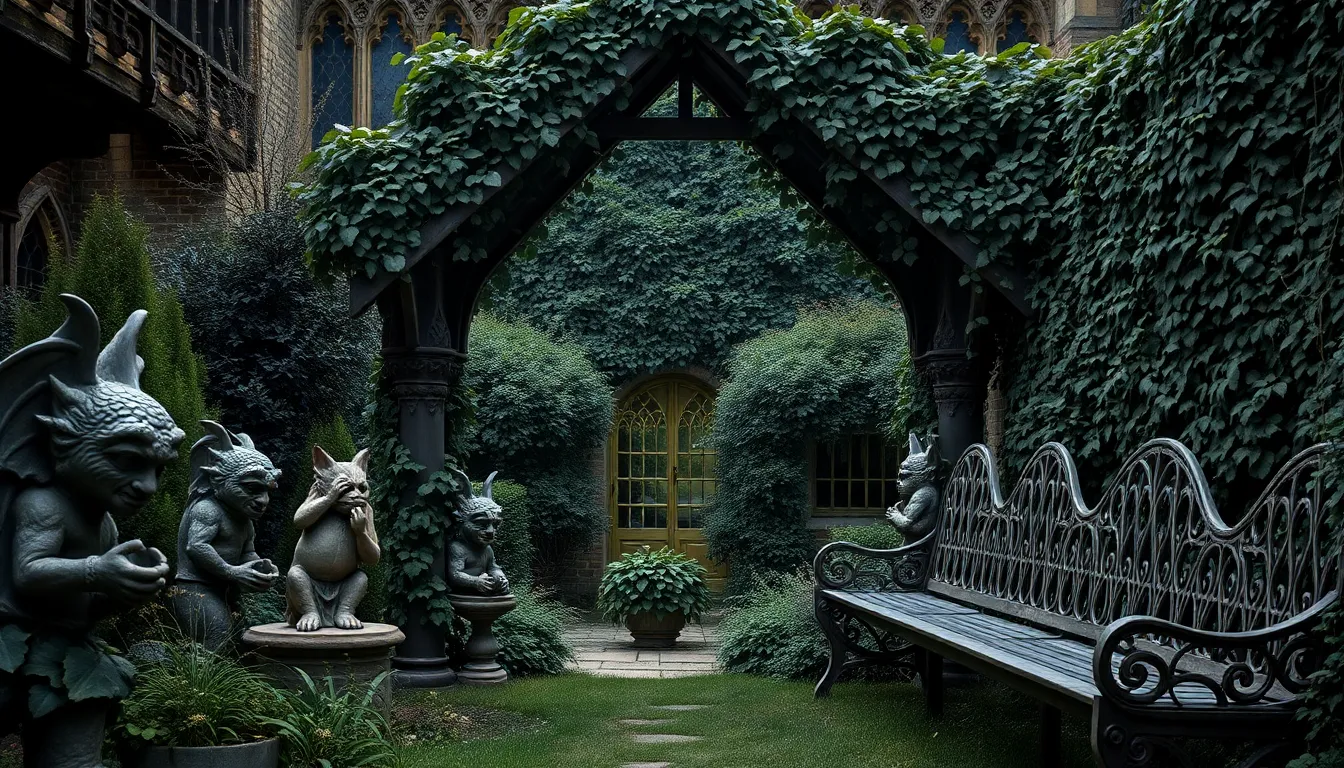
We’ll elevate our dark botanical sanctuary by incorporating architectural features that echo medieval grandeur and Victorian sophistication. These structural elements serve as the foundation for creating an authentically gothic atmosphere that complements our dramatic foliage and mysterious pathways.
Stone Gargoyles and Grotesque Sculptures
Stone gargoyles create commanding focal points throughout our gothic garden industry. We can position these weathered guardians near entrances, along pathways, or beside water features to establish an atmosphere of ancient mystique. Traditional limestone or concrete reproductions offer durability while maintaining the aged appearance that defines authentic gothic design.
Grotesque sculptures add layers of visual intrigue beyond simple decorative appeal. We’ll strategically place cherub statues, mythical creatures, and ornate stone urns to create conversation pieces that draw visitors deeper into our garden’s narrative. These sculptural elements work best when partially concealed by dark foliage or positioned at the intersection of multiple pathways.
Weathered finishes enhance the historical authenticity of our stone features. We can accelerate the aging process using moss milk answers or strategic placement in naturally damp areas where organic growth occurs naturally. The contrast between smooth carved details and rough, moss-covered surfaces creates the perfect gothic juxtaposition.
Pointed Arch Trellises and Pergolas
Pointed arch trellises establish the quintessential gothic silhouette that defines medieval architecture. We’ll construct these frameworks using wrought iron or dark-stained wood to support climbing roses, ivy, or other dramatic vines. The vertical emphasis of pointed arches draws the eye upward while creating natural frames for garden views.
Pergolas with intricate gothic details provide substantial overhead structure for larger garden spaces. We can incorporate ornate brackets, carved wooden elements, or decorative ironwork that echoes cathedral architecture. These substantial features support heavy climbing plants while creating shaded seating areas beneath.
Strategic placement maximizes architectural impact across our garden design. We’ll position these structures to frame important views, create natural transitions between garden rooms, or establish focal points at pathway intersections. The repetition of pointed arch motifs throughout the space reinforces our gothic theme.
Medieval-Style Garden Benches
Medieval-style benches provide authentic period seating that invites contemplation within our gothic sanctuary. We’ll select or commission pieces featuring heavy stone construction, ornate carved details, or wrought iron accents that complement our other architectural elements. Antique reproductions offer the weathered appearance of genuine historical pieces.
Strategic bench placement creates intimate gathering spots throughout our garden journey. We can position these seats to face dramatic sculptural features, overlook reflecting pools, or provide rest stops along winding pathways. The solid, substantial appearance of medieval-inspired furniture reinforces the timeless quality of our gothic design.
Weather-resistant materials ensure lasting beauty even though outdoor exposure. We’ll choose benches crafted from natural stone, cast concrete, or treated hardwoods that develop attractive patina over time. The integration of these functional elements into our overall design scheme creates practical spaces for enjoying our dark botanical masterpiece.
Incorporate Water Features With Dark Appeal
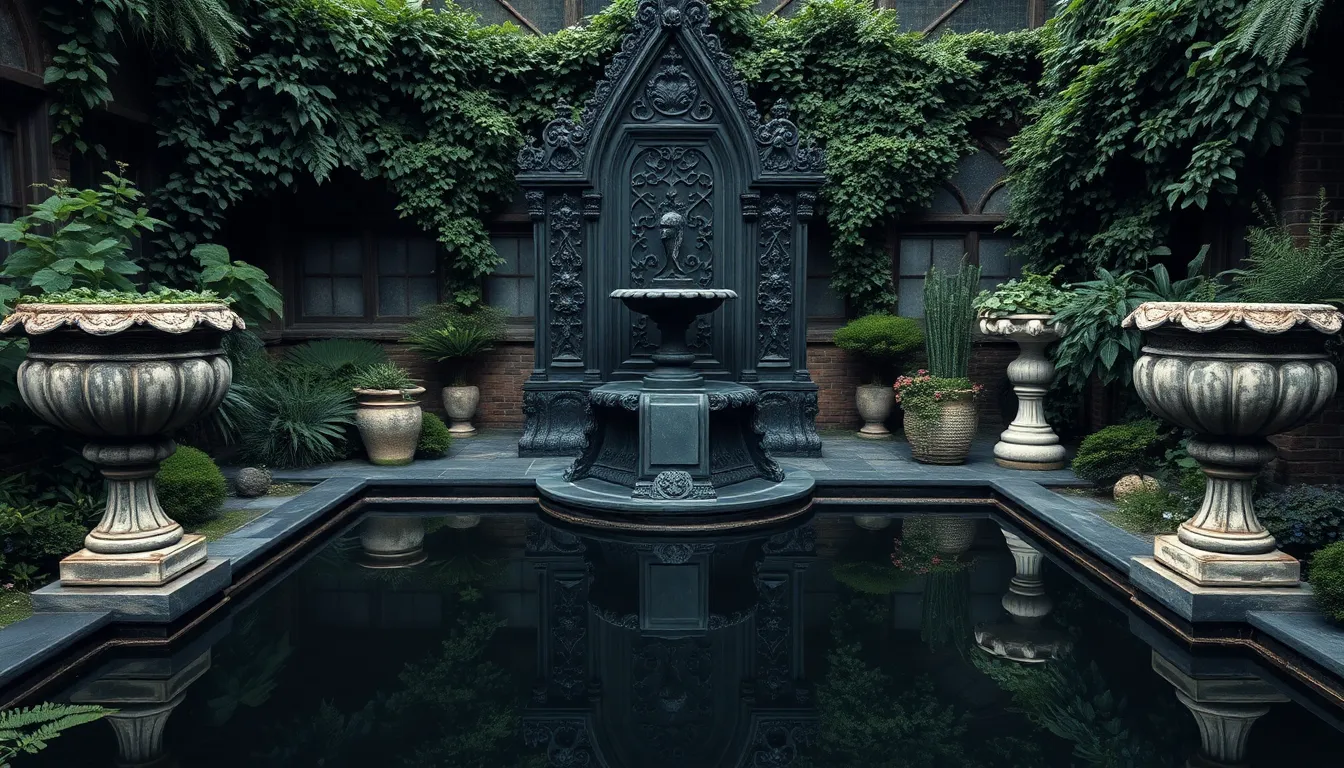
Water transforms our gothic gardens into mesmerizing sanctuaries that whisper secrets through gentle flows and mysterious reflections. We’ll explore three powerful water features that amplify the dark romantic atmosphere we’ve been cultivating.
Black Stone Fountains With Gothic Details
Black stone fountains command attention as dramatic centerpieces in our gothic garden design. We recommend selecting fountains crafted from dark granite or slate, featuring intricate gothic details like pointed arches and ornate carvings that echo medieval cathedrals. These architectural elements create stunning focal points that anchor our garden’s mysterious ambiance.
Positioning becomes crucial when we install these statement pieces. We suggest placing black stone fountains at pathway intersections or within enclosed garden rooms where their gothic details can be fully appreciated. The sound of cascading water adds an auditory layer that enhances the contemplative atmosphere we’ve established with our dark foliage and architectural features.
Maintenance proves surprisingly simple with black stone materials. We find that dark surfaces hide mineral deposits better than light colored alternatives, keeping our fountains looking pristine with minimal effort. The natural weathering process actually improves their authentic gothic appearance over time.
Reflecting Pools With Dark Liners
Reflecting pools create ethereal mirrors that double the visual impact of our surrounding gothic elements. We install dark rubber or vinyl liners in black or deep charcoal tones to achieve that mysterious, almost supernatural quality that defines gothic garden design. These pools capture reflections of our stone arches, wrought iron features, and dramatic plant selections.
Sizing considerations help us maximize the reflective effect without overwhelming smaller garden spaces. We typically recommend pools ranging from 4 to 8 feet in diameter, depending on the available area and surrounding features. Shallow depths of 12 to 18 inches work perfectly for reflection purposes while remaining safe and manageable.
Strategic placement amplifies the gothic atmosphere we’ve carefully constructed. We position reflecting pools where they can mirror our most striking architectural elements, such as pointed arch trellises or stone gargoyles. Evening lighting transforms these pools into captivating focal points that seem to glow with otherworldly energy.
Weathered Urns as Water Vessels
Weathered urns bring authentic antiquity to our gothic water features while creating intimate gathering points throughout the garden. We select urns made from cast iron, aged concrete, or natural stone that show signs of weathering and patina development. These vessels can hold water for birds or simply create the illusion of ancient garden remnants.
Placement strategies help us create layered visual interest across different garden zones. We arrange multiple urns of varying heights and styles to establish rhythm and movement through our pathways and planted areas. Some urns can overflow gently into surrounding plantings, while others remain still and contemplative.
Practical considerations make these features both beautiful and functional. We ensure proper drainage in urns that aren’t meant to hold standing water, preventing damage during freeze cycles. For urns serving as bird baths or small water features, we add small pumps or fountainheads to keep water moving and fresh, supporting our garden’s network while maintaining the gothic aesthetic.
Add Dramatic Lighting for Nighttime Ambiance
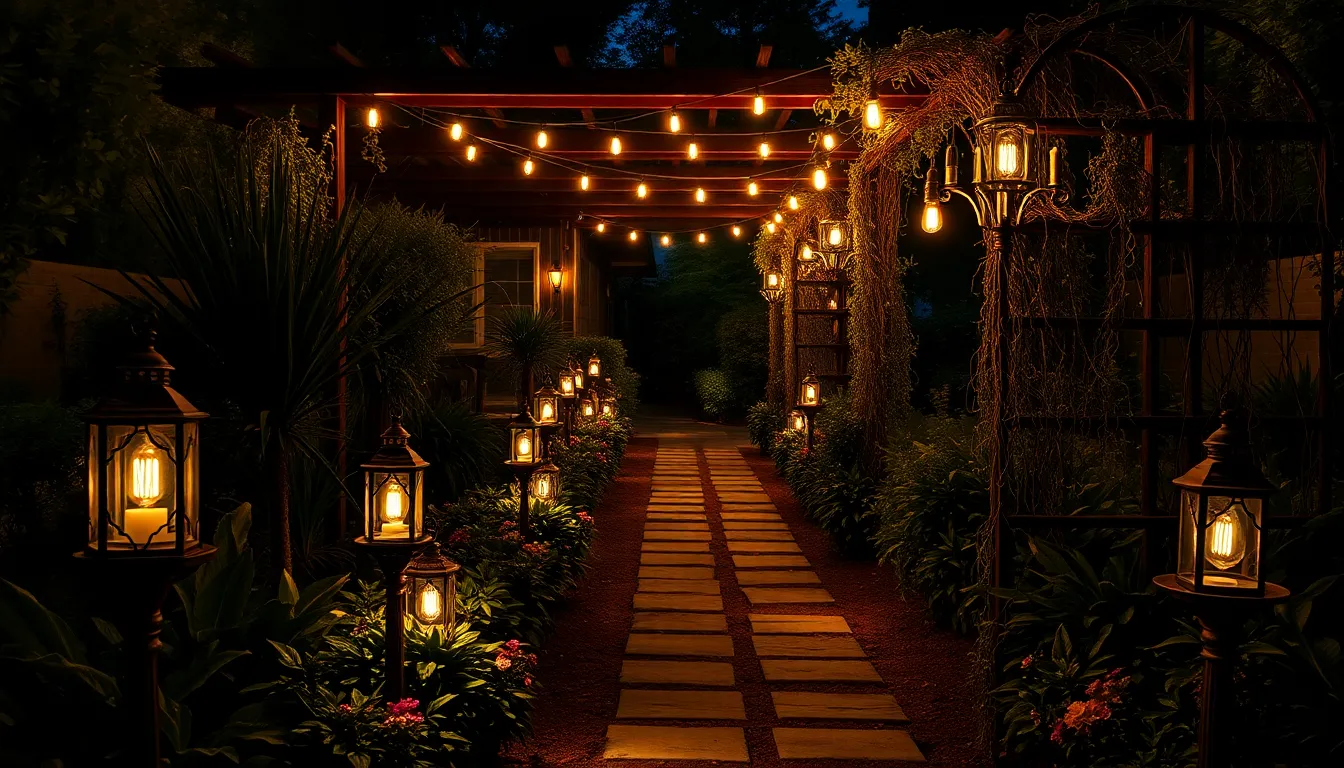
Transforming our gothic garden into an enchanting nocturnal sanctuary requires carefully planned lighting that amplifies the mysterious atmosphere we’ve cultivated. Strategic illumination creates shadowy depths and ethereal glows that make architectural features and dark foliage come alive after sunset.
Lantern-Style Path Lighting
Vintage wrought iron lanterns create the perfect shadowy atmosphere along our garden pathways. We position these atmospheric fixtures at regular intervals to cast pools of light that guide visitors while maintaining the mysterious ambiance. Weathered metal finishes complement our gothic architectural elements and enhance the historical authenticity of our space.
Installing lanterns on pedestals or mounting them on decorative posts adds vertical interest to our pathways. We select models with aged patina or distressed finishes that echo the weathered stone and iron elements throughout our garden. Gas flame effect LED bulbs provide flickering light that mimics candlelight without maintenance concerns.
Candelabra Garden Stakes
Electric candelabra stakes bring flickering charm directly into our flower beds and around seating areas. We place these dramatic fixtures among our dark foliage plants like Black Prince coleus and Dark Side of the Moon astilbe to create intimate pools of light. Multiple candle flames on each stake multiply the romantic effect while illuminating the rich textures of our gothic plantings.
Positioning candelabra stakes near our medieval style benches creates perfect reading nooks for evening contemplation. We choose models with ornate metalwork that matches our wrought iron gates and architectural features. Battery operated versions offer flexibility in placement without running electrical lines through established garden beds.
String Lights With Vintage Edison Bulbs
Edison bulb string lights cast a warm golden glow that transforms pergolas, fences, and tree canopies into magical overhead features. We drape these timeless lights across our pointed arch trellises to emphasize their gothic silhouettes against the night sky. The vintage bulb style adds historical charm while providing ambient illumination that doesn’t overpower our garden’s moody atmosphere.
Connecting multiple strands creates a canopy effect that unifies different garden rooms and pathways. We secure the lights to our stone archways and wrought iron structures using weatherproof clips that blend with the existing materials. Dimmable LED Edison bulbs allow us to adjust the intensity based on the occasion while maintaining energy efficiency throughout the growing season.
Create Cemetery-Inspired Garden Sections
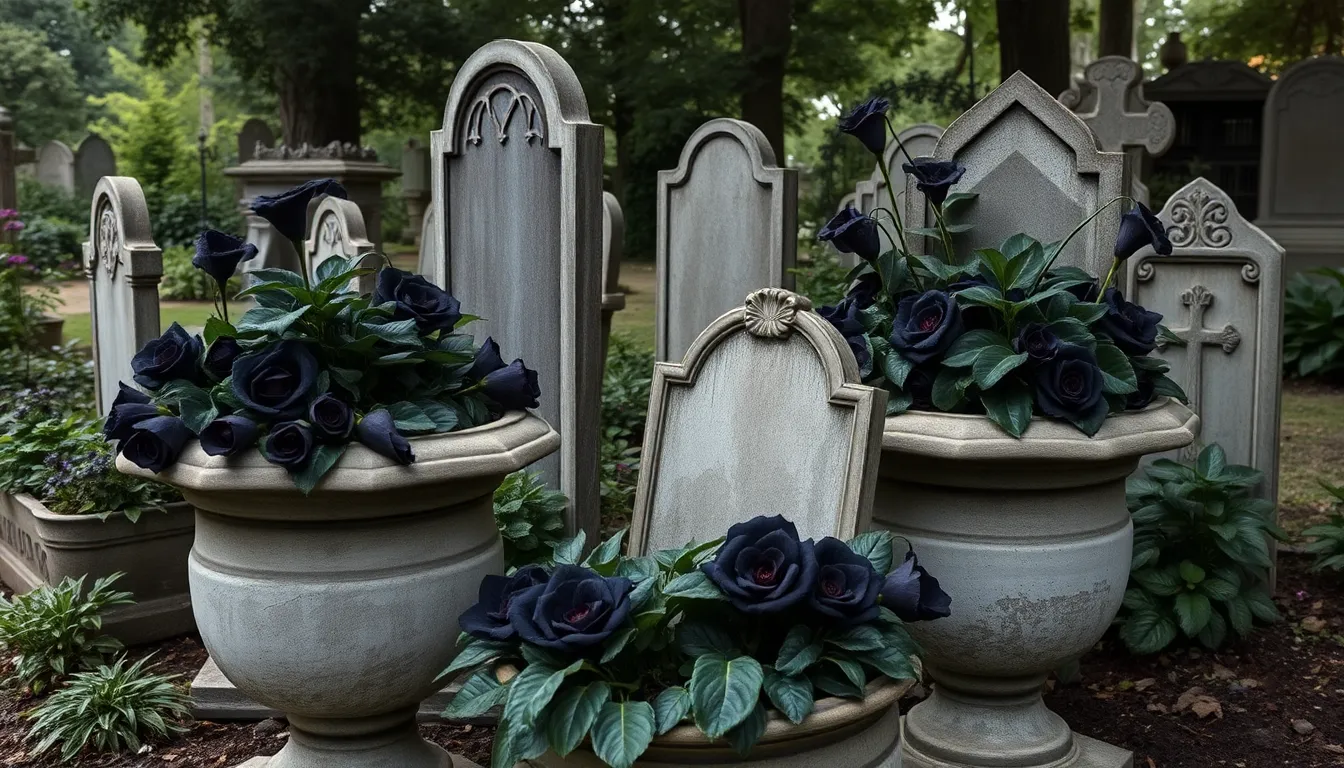
Gothic gardens reach their haunting peak when we integrate cemetery-inspired elements that blur the line between life and eternal rest. These atmospheric sections transform ordinary garden spaces into mysterious landscapes that tell stories of bygone eras.
Antique Headstone Replicas as Decorations
Replica gravestones serve as dramatic focal points that anchor our gothic garden’s most compelling narrative elements. We can source these weathered monuments from architectural salvage shops or commission custom pieces that feature gothic fonts and symbolic engravings. Antique shops often carry authentic-looking replicas that bring instant historical weight to our design.
Placement strategies maximize the visual impact of these memorial elements throughout our garden industry. We position headstone replicas among black roses and deep purple flowering plants to create solemn vignettes that feel authentically storybook. Border arrangements work particularly well when we line pathways with smaller replica markers that guide visitors through our cemetery-inspired sections.
Weathered finishes on these decorative elements enhance their authenticity and historical presence. We achieve this aged appearance through careful selection of pre-weathered pieces or by applying aging techniques to newer replicas. Gothic symbols like crosses, angels, and ivy motifs carved into the stone surfaces reinforce our garden’s mysterious character.
Weathered Concrete Planters
Cracked and aged concrete planters bring authentic cemetery atmosphere to our gothic garden sections. We select containers that show signs of weathering, including surface cracks, moss stains, and naturally aged patinas that suggest decades of exposure to the elements. These planters create the perfect foundation for our darkest botanical selections.
Aging techniques transform new concrete planters into convincingly weathered garden vessels. We apply moss and yogurt mixtures to encourage natural moss growth across the planter surfaces, creating that coveted aged look. Paint treatments using diluted browns and grays can simulate years of weather exposure when we apply them strategically to mimic natural aging patterns.
Resale vendors and architectural salvage yards often stock pre-aged concrete planters that save us time while delivering authentic results. We hunt for pieces with natural weathering, interesting cracks, and unique patina that add character to our cemetery-inspired garden sections. These authentic finds become conversation pieces that anchor our gothic industry design.
Memorial Garden Spaces With Remembrance Plants
Memorial spaces within our gothic garden create intimate areas for contemplation and remembrance. We design these sections around memorial benches or statuary that serve as focal points for quiet reflection. Winding paths lead visitors to these secluded corners that mirror the peaceful atmosphere found in old churchyards.
Dark-colored plant selections define our memorial garden spaces with their melancholic beauty and symbolic significance. We plant black roses like Rosa ‘Black Baccara’ alongside black hollyhocks and Diablo ninebark to create dramatic color schemes. Black calla lilies and dark-leaved heucheras complete these memorial plantings with their striking foliage and mysterious presence.
Strategic placement of remembrance plants near memorial elements enhances both visual appeal and symbolic meaning. We position our darkest specimens around headstone replicas and weathered planters to create cohesive vignettes that feel both haunting and beautiful. These memorial garden spaces become the emotional heart of our gothic industry, where visitors can connect with the deeper themes of our cemetery-inspired design.
Use Gothic Color Schemes Throughout
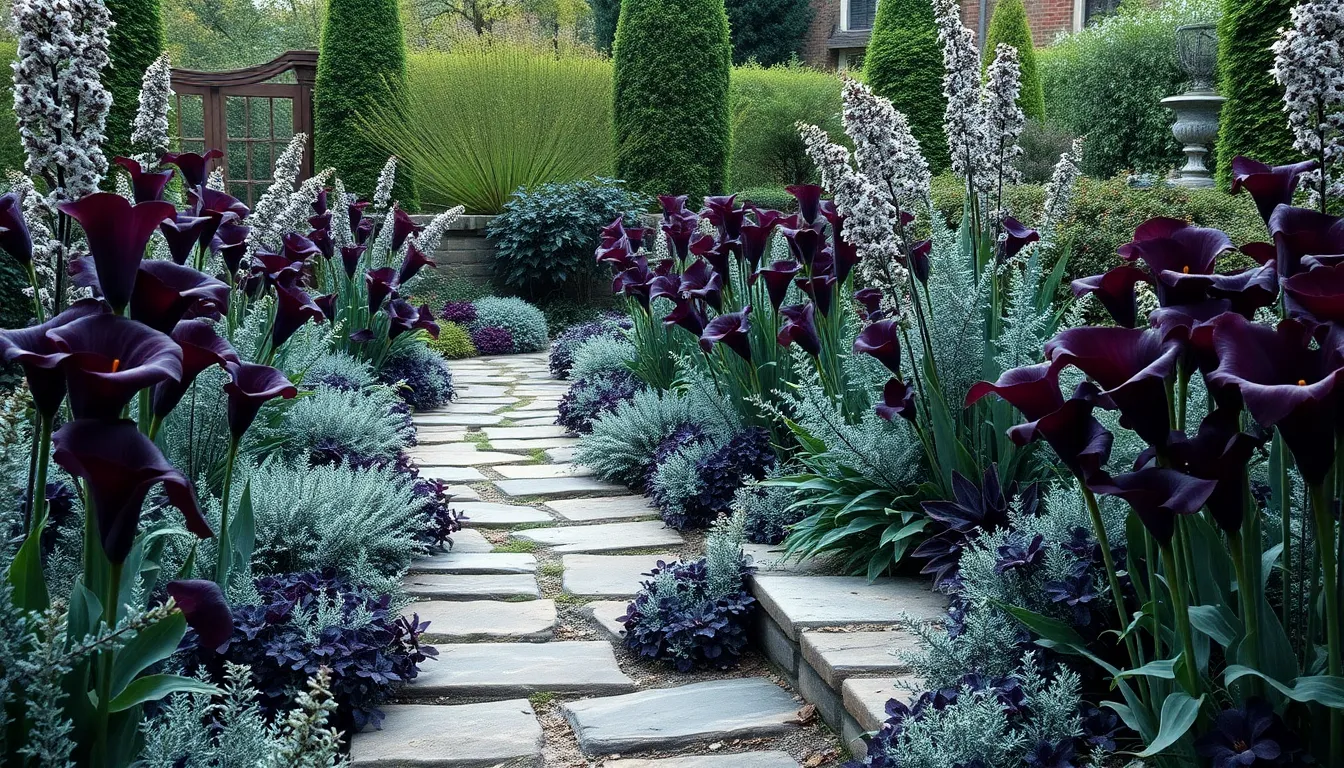
Color serves as the foundation for establishing your gothic garden’s mysterious atmosphere. We’ll explore three essential color schemes that transform ordinary spaces into darkly romantic sanctuaries.
Deep Purples and Burgundy Combinations
Deep purple and burgundy combinations create the most dramatic impact in gothic garden design. We recommend incorporating black calla lilies as striking focal points throughout your flower beds, as their rich purple-black petals embody the essence of gothic elegance. Burgundy coleus adds vibrant depth to shaded areas while maintaining the mysterious color palette.
Plants like ‘Black Pearl’ coral bells provide deep burgundy foliage that intensifies throughout the growing season. We suggest pairing these with purple-leafed varieties of Japanese maple to create layered canopies of rich color. Dark purple tulips and deep burgundy dahlias offer seasonal blooms that complement the permanent plantings.
Consider adding purple smoke bush for its dramatic cloud-like appearance and deep wine-colored foliage. We’ve found that grouping these plants in odd numbers creates more natural-looking arrangements while maximizing their visual impact.
Black and Silver Plant Pairings
Black and silver plant pairings deliver striking contrast that captures moonlight and creates ethereal beauty in gothic spaces. We recommend combining black petunias with silver wormwood to achieve this captivating effect throughout your garden beds.
Silver artemisia provides feathery texture that softens the intensity of dark-flowered companions like black hollyhocks or near-black pansies. We suggest using dusty miller as a silvery border plant to frame darker specimens and create definition between planting areas.
Lamb’s ear offers velvety silver foliage that contrasts beautifully with black-eyed susans or dark purple salvia. We position these combinations near pathways where visitors can appreciate the dramatic interplay between light and shadow.
Black elephant ears paired with silver sage create bold architectural statements in larger garden spaces. We’ve discovered that repeating these combinations throughout the garden maintains visual cohesion while preventing any single area from appearing too stark.
Monochromatic Gray Gardens
Monochromatic gray gardens establish sophisticated gothic atmospheres through subtle variations in tone and texture. We use various shades of gray through weathered stone elements, silver gravel pathways, and carefully selected gray-leafed plants like Diablo ninebark.
Gray-leafed plants such as lavender cotton and silver mound artemisia provide different textures while maintaining the monochromatic scheme. We incorporate crushed gray stone mulch around these plantings to reinforce the unified color palette and reduce maintenance needs.
Weathered concrete planters and aged stone sculptures blend seamlessly into monochromatic designs while adding structural interest. We position these elements strategically to create focal points without disrupting the garden’s subtle color harmony.
Russian sage and silver willow contribute height variations to monochromatic plantings while their gray-green foliage maintains the sophisticated palette. We’ve found that adding occasional white flowers like white roses or moonflower vines enhances the gray scheme without breaking its mysterious spell.
Build Vertical Gothic Garden Features
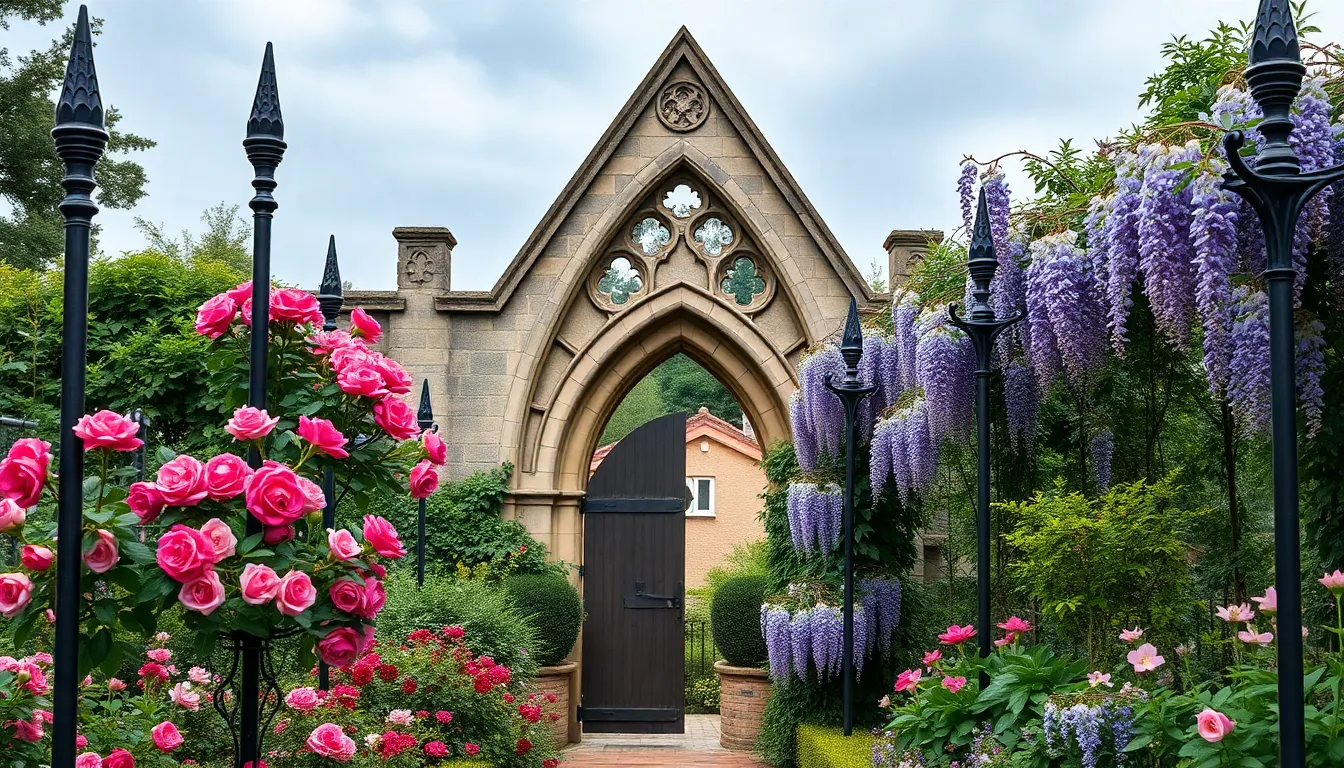
Gothic gardens reach their full dramatic potential when we incorporate towering elements that draw the eye upward. These vertical features create architectural interest while adding layers of mystery to our dark botanical sanctuary.
Climbing Rose Towers on Dark Obelisks
Dark obelisks serve as commanding supports for climbing roses and create striking vertical drama in our gothic garden design. We recommend selecting black metal or weathered stone obelisks that stand 6 to 8 feet tall to provide adequate support for vigorous climbing varieties. Position these towers strategically at pathway intersections or garden corners where they’ll function as dramatic focal points while supporting our chosen climbing plants.
Black climbing roses like ‘Mister Lincoln’ or deep burgundy varieties such as ‘Don Juan’ pair beautifully with dark obelisk supports. Alternative climbing plants include dark purple clematis or black morning glories that spiral upward to create cascading towers of gothic elegance. Install the obelisks deep into the ground with at least 18 inches of burial depth to ensure stability as plants mature and add weight to the structure.
Gothic Revival Garden Structures
Stone arches and wrought iron gates establish the quintessential gothic revival atmosphere we’re seeking in our vertical garden design. Weathered stone archways create natural portals that frame garden views and provide support for climbing vines with dark foliage. We can construct these arches using reclaimed limestone or aged brick to achieve an authentic historical appearance that suggests centuries of garden history.
Wrought iron gates with intricate scrollwork and pointed details serve dual purposes as functional barriers and artistic statements. Look for gates featuring gothic motifs like trefoils, quatrefoils, or lancet arch patterns that echo medieval cathedral architecture. Mount these gates within stone or brick pillars to create substantial entrance features that command attention and respect.
Ancient style doorways and weathered trellises add layers of vertical interest throughout our gothic garden space. Salvaged materials from old buildings or specially crafted reproductions help us achieve the weathered patina that suggests age and mystery.
Pointed Spire Plant Supports
Pointed spire supports mimic the soaring architecture of gothic cathedrals and provide elegant structure for our climbing plants. These supports feature sharp, upward pointing tops that create dramatic silhouettes against the sky while offering practical growing space for vines and climbing flowers. Metal spires work particularly well when finished in dark colors like charcoal, deep bronze, or weathered black iron.
Garden centers offer ready made pointed plant supports ranging from 4 to 10 feet in height. Custom metalwork allows us to create unique spire designs that incorporate gothic architectural details like crockets, finials, or decorative ironwork patterns. Space multiple spires throughout the garden to create rhythm and repetition that unifies our gothic design theme.
Training dark flowered clematis or purple wisteria up these pointed supports creates living sculptures that change with the seasons. The combination of architectural form and organic growth produces the perfect balance between structure and natural beauty that defines successful gothic garden design.
Conclusion
Creating a gothic garden isn’t just about adding dark plants and mysterious elements – it’s about crafting a cohesive sanctuary that tells a story. We’ve shown you how each component from dramatic entrances to cemetery-inspired features works together to build an enchanting atmosphere.
Your gothic garden will become a year-round source of intrigue and beauty. The carefully chosen plants maintain their dramatic appeal through every season while architectural features provide lasting structure and visual impact.
Remember that successful gothic garden design lies in the details. Whether you’re incorporating a single dramatic focal point or transforming your entire outdoor space these elements will help you achieve that perfect balance of elegance and mystery that defines truly captivating gothic gardens.
Frequently Asked Questions
What is gothic garden design?
Gothic garden design is a landscaping style that merges dark romance with botanical beauty to create mysterious and enchanting outdoor spaces. It draws inspiration from Victorian elegance and supernatural charm, featuring elements like dark-colored plants, wrought iron accents, weathered stone, and dramatic architectural features that evoke a sense of mystery and allure.
What plants work best in a gothic garden?
Gothic gardens thrive with dark foliage plants like Astilbe ‘Dark Side of the Moon,’ Coleus ‘Black Prince,’ and Heuchera ‘Black Pearl.’ Black flowers such as black calla lilies and black petunias create dramatic impact, while silver-leafed plants like Dusty Miller provide ethereal contrast. Evergreen shrubs like Ninebark Diabolo® maintain year-round structure.
How do I create dramatic pathways in a gothic garden?
Use dark materials like black gravel, crushed stone, or weathered brick in herringbone patterns for authentic gothic pathways. Natural stone steps with moss accents add elevation and drama. These dark walkways serve as arteries that guide visitors deeper into the garden while enhancing the mysterious atmosphere.
What architectural features enhance a gothic garden?
Key architectural elements include wrought iron gates with intricate patterns, stone gargoyles and grotesque sculptures, pointed arch trellises and pergolas, and medieval-style benches. Stone archways covered in dark ivy create natural portals, while weathered concrete planters and antique headstone replicas add cemetery-inspired drama.
How should I light a gothic garden?
Use vintage wrought iron lanterns along pathways for shadowy atmospheres, electric candelabra stakes in flower beds for flickering charm, and string lights with Edison bulbs over pergolas for warm ambient glow. These lighting elements complement the gothic aesthetic while providing practical illumination after sunset.
What water features work in gothic gardens?
Black stone fountains make dramatic centerpieces at pathway intersections, while reflecting pools with dark liners create ethereal qualities that capture gothic element reflections. Weathered urns add authenticity and intimacy. These water features enhance the mysterious ambiance while maintaining the overall gothic theme.
What color schemes work best for gothic gardens?
Effective gothic color schemes include deep purples and burgundies, striking black and silver pairings, and sophisticated monochromatic gray designs. Use plants like burgundy coleus, purple smoke bush, black petunias, and silver wormwood to create dramatic contrasts and enhance the mysterious gothic atmosphere.
How do I add vertical interest to a gothic garden?
Incorporate dark obelisks to support climbing roses, stone arches and wrought iron gates for gothic revival atmosphere, and pointed spire plant supports that mimic cathedral architecture. These vertical elements create architectural interest, add layers of mystery, and unify the overall gothic design theme.

